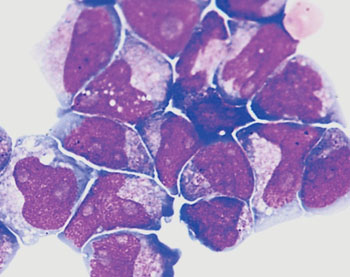Early and Accurate Prediction of Leukemia Made Possible
By LabMedica International staff writers
Posted on 25 Jan 2016
Acute myeloid leukemia (AML) is the most common type of leukemia in adults and recent studies demonstrate that early and accurate prediction of this aggressive cancer is possible how it will develop in individuals.Posted on 25 Jan 2016
Scientists have been able to fingerprint myelodysplastic syndromes (MDS), a state for blood cells that turns into AML cancer in approximately 30% of patients. The study demonstrates that early and accurate prediction of this aggressive cancer is possible.

Image: Bone marrow aspirate of acute myeloid leukemia: Azurophilic granularity can be seen in essentially all of the blasts and variability in nuclear size and contour is observable (Photo courtesy of Dr. John Lazarchick, MD).
Scientists at McMaster University (Hamilton, ON, Canada) collaborated with those at the University of Bologna (Italy) to perform a retrospective study on human blood samples that had been previously collected from patients with MDS, some of whom eventually developed AML. Gene expression analysis of patient blood samples was accurate in predicting which patients would develop AML and which would not.
The study revealed that removal of glycogen synthase kinase-3α (GSK-3α) and GSK-3β dependency leads to aggressive AML. Although GSK-3α deletion alone has no effect, GSK-3β deletion in hematopoietic stem cells (HSCs) resulted in a pre-neoplastic state consistent with human myelodysplastic syndromes (MDSs). Transcriptome and functional studies reveal that each GSK-3β and GSK-3α uniquely contributes to AML by affecting Wnt/Akt/mTOR signaling and metabolism, respectively. The molecular signature of HSCs deleted for GSK-3β provided a prognostic tool for disease progression and survival of MDS patients. The study revealed that GSK-3α- and GSK-3β-regulated pathways can be responsible for stepwise transition to MDS and subsequent AML, thereby providing potential therapeutic targets of disease evolution.
Mickie Bhatia, PhD, a professor and lead investigator, said, “This discovery improves our ability to identify which patients with MDS will develop AML. However, our next step is to go beyond better predictive measures for the development of a blood cancer, and use this predictive gene expression as a target for drugs to prevent AML from developing altogether. This will be part of a new era of genetic-based drug discovery.” The study was published on January 11, 2016, in the journal Cancer Cell.
Related Links:
McMaster University
University of Bologna














